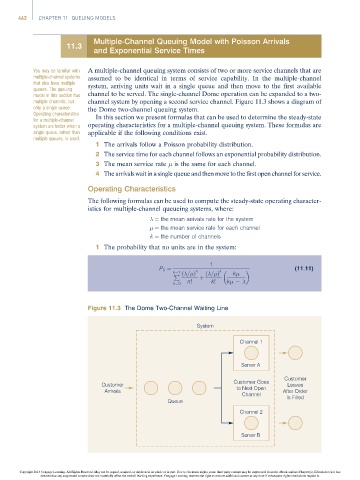Page 482 -
P. 482
462 CHAPTER 11 QUEUING MODELS
Multiple-Channel Queuing Model with Poisson Arrivals
11.3
and Exponential Service Times
You may be familiar with A multiple-channel queuing system consists of two or more service channels that are
multiple-channel systems assumed to be identical in terms of service capability. In the multiple-channel
that also have multiple
queues. The queuing system, arriving units wait in a single queue and then move to the first available
model in this section has channel to be served. The single-channel Dome operation can be expanded to a two-
multiple channels, but channel system by opening a second service channel. Figure 11.3 shows a diagram of
only a single queue. the Dome two-channel queuing system.
Operating characteristics
for a multiple-channel In this section we present formulas that can be used to determine the steady-state
system are better when a operating characteristics for a multiple-channel queuing system. These formulas are
single queue, rather than applicable if the following conditions exist.
multiple queues, is used.
1 The arrivals follow a Poisson probability distribution.
2 The service time for each channel follows an exponential probability distribution.
3 The mean service rate is the same for each channel.
4 The arrivals wait in asingle queueand then move to the first open channel for service.
Operating Characteristics
The following formulas can be used to compute the steady-state operating character-
istics for multiple-channel queueing systems, where:
¼ the mean arrivals rate for the system
¼ the mean service rate for each channel
k ¼ the number of channels
1 The probability that no units are in the system:
1
P 0 ¼ (11:11)
k 1 n ð = Þ k k
P ð = Þ
þ
n¼0 n! k! k
Figure 11.3 The Dome Two-Channel Waiting Line
System
Channel 1
Server A
Customer
Customer Customer Goes Leaves
Arrivals to Next Open After Order
Channel Is Filled
Queue
Channel 2
Server B
Copyright 2014 Cengage Learning. All Rights Reserved. May not be copied, scanned, or duplicated, in whole or in part. Due to electronic rights, some third party content may be suppressed from the eBook and/or eChapter(s). Editorial review has
deemed that any suppressed content does not materially affect the overall learning experience. Cengage Learning reserves the right to remove additional content at any time if subsequent rights restrictions require it.

